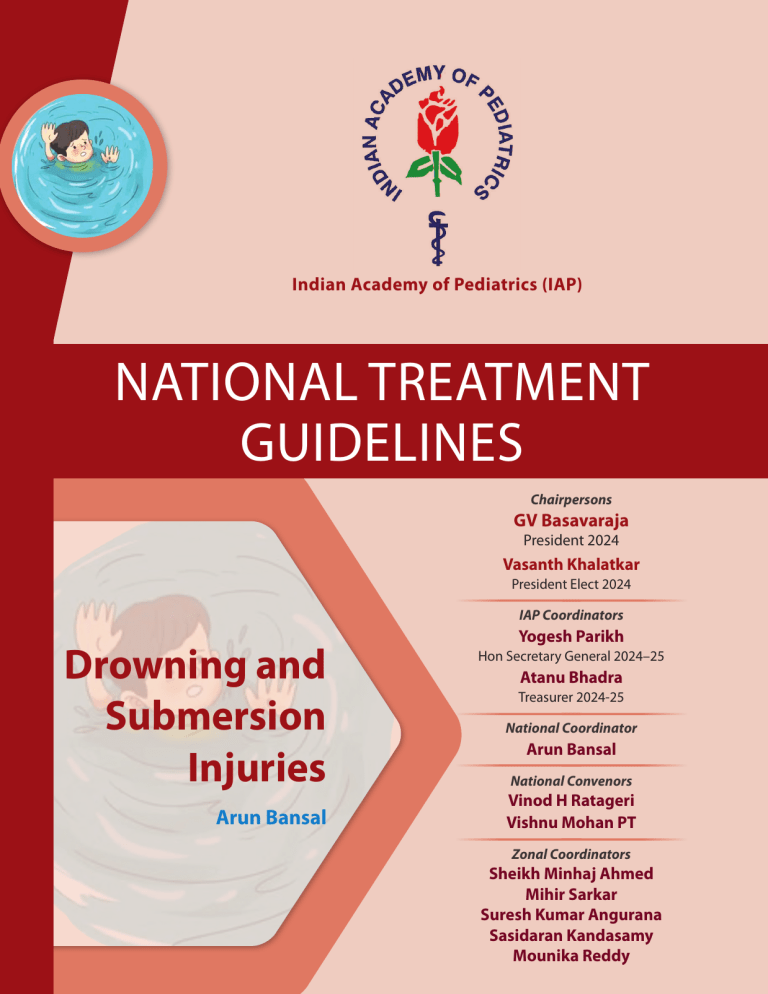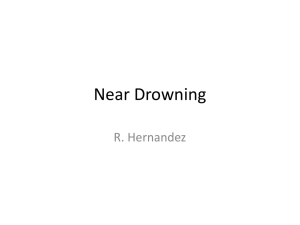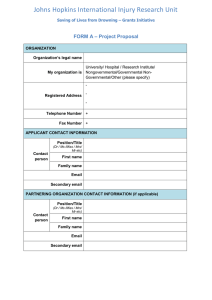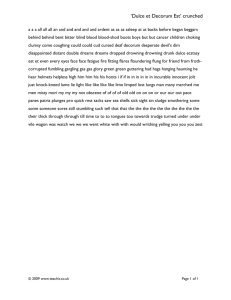Uploaded by
Mahesh Vasava
Drowning & Submersion Injuries: National Treatment Guidelines
advertisement

Indian Academy of Pediatrics (IAP) NATIONAL TREATMENT GUIDELINES Chairpersons GV Basavaraja President 2024 Vasanth Khalatkar President Elect 2024 IAP Coordinators Drowning and Submersion Injuries Arun Bansal Yogesh Parikh Hon Secretary General 2024–25 Atanu Bhadra Treasurer 2024-25 National Coordinator Arun Bansal National Convenors Vinod H Ratageri Vishnu Mohan PT Zonal Coordinators Sheikh Minhaj Ahmed Mihir Sarkar Suresh Kumar Angurana Sasidaran Kandasamy Mounika Reddy Drowning and Submersion Injuries 1 INCIDENCE The World Health Organization (WHO) reports that drowning is a preventable public health issue, claiming about 40 lives every hour throughout the day. Over 90% of these deaths occur in lowand middle-income countries, making it the third most significant cause of unintentional injuries worldwide.1 International data significantly underestimates drowning mortality rates in high-income nations, while survey data from low- and middle-income countries suggests rates four to five times the WHO calculated rate.1 DEFINITION Drowning is the process of experiencing respiratory impairment from submersion or immersion in liquid.2 If there is no breathing impairment, this is a rescue rather than a drowning. TYPES Nonfatal drowning occurs when the victim is rescued at any juncture, thereby interrupting the progression of the drowning process. Fatal drowning: Losing the victim at any moment constitutes a fatal drowning. The usage of phrases such as “dry or wet drowning,” “near-drowning,” and “secondary drowning” is incorrect. The Utstein template is a standardized method for documenting data about drowning resuscitation cases.3 Drowning and Submersion Injuries Nonfatal Drowning Categorization Framework The WHO has classified the severity of respiratory impairment and morbidity in nonfatal drowning as given in Table 1. Morbidity is a reduction in the individual’s functional capacity relative to their predrowning state. TABLE 1: Nonfatal drowning categorization framework (NDCF). The severity of respiratory impairment after the drowning process stopped Mild impairment y y y Breathing Involuntary distressed coughinga And Fully alert Moderate impairment y y Difficulty breathing And Disoriented but conscious Severe impairment y y Not breathing And Unconscious Morbidity category (based on any decline from previous functional capacityb) at the time of measurement A. No morbidity B. Some morbidity C. Severe morbidity No decline Some decline Severe decline Involuntary distressed coughing: Coughing up liquid/moving liquid out of the airway; in water, in distress and coughing; sustained coughing. b Previous functional capacity: It includes the person’s cognitive, motor, and psychological capacity. a PATHOPHYSIOLOGY Aspirating water into the airways causes coughing as a reflex response. Less than 2% of cases may exhibit laryngospasm, which is immediately terminated by the onset of hypoxia. Continuing aspiration of water can cause hypoxemia, leading to loss of consciousness and apnea within seconds to minutes if not rescued. Hypoxic cardiac arrest typically follows bradycardia and pulseless electrical activity, not ventricular fibrillation or tachycardia. Water in alveoli destroys and washes out surfactant, leading to acute lung injury. It also disrupts alveolar–capillary membrane integrity, increases permeability, and worsens fluid, plasma, and electrolyte changes. A clinical picture of localized or widespread pulmonary edema is manifested, affecting the alveolar exchange of oxygen and carbon dioxide. Water aspiration of 1–3 mL/kg can significantly disrupt pulmonary gas exchange and reduce compliance by 10–40%. Lung fluid, surfactant loss, and increased capillary–alveolar permeability can cause reduced compliance, increased right-to-left shunting, atelectasis, and alveolitis, leading to noncardiogenic pulmonary edema. 3 Drowning and Submersion Injuries MANAGEMENT IN THE EMERGENCY ROOM The key to successful resuscitation of a drowning patient is effective rewarming and following advanced life support (ALS) guidelines with correction of hypoxemia and acidosis. The detailed management in ER is as per Table 2. TABLE 2: Management of a child with drowning. Basic management y y y y y y Careful history and examination Continuous vital sign monitoring Record temperature C-spine stabilization Dry the chest before using defibrillator Look for any external or internal injury Child is conscious with no respiratory distress Basic management Child is conscious with respiratory distress y y y y y y Child is unconscious or having cardiac arrest y y y y y y Passive rewarming: y Remove wet clothes y Dry the patient y Warm blanket y Warm environment Active rewarming (if core temperature <30°C): y Warm IV fluids (39°C) y Warm saline (42°C) gastric or bladder lavage Consider ECG Discharge with safety advise Basic management Oxygen Ventilatory support (invasive or noninvasive) IV fluid (warm) Rewarming (active or passive as per need) Hemodynamic support (as per need) y Intubate and ventilate Nasogastric tube IV/ IO access Treat shock with fluids IV fluid (warm) Rewarming (active and passive) y y y y y y y y y y y y y CXR ECG CBC LFT Electrolytes Blood gas Needs admission in ER/ Ward/PICU CXR ECG CBC LFT Electrolytes Blood gas Blood glucose Consider CT head Shift to PICU (CBC: complete blood count; CXR: chest X-ray; ER: emergency room; ECG: electrocardiogram; IO: intraosseus; IV: intravenous; LFT: liver function test; PICU: pediatric intensive care unit) Ventilation In a conscious child with no distress, low-flow oxygen through a nasal cannula or face mask may be sufficient. 4 Drowning and Submersion Injuries A child with distress may require high-flow nasal cannula (HFNC) or noninvasive ventilation (NIV) support. An unconscious child will need intubation and mechanical ventilation: Lung protective ventilation strategy Low tidal volume High positive end-expiratory pressure (PEEP) may be required. Fluids If shock is present, give IV saline at 10 mL/kg. Continuous hemodynamic monitoring Use echocardiography to monitor fluids and inotropes as early myocardial dysfunction is known in hypothermia. Correction of Metabolic and Electrolyte Abnormalities Correction of hypoxemia and fluid status will improve acidosis. There is no benefit of using sodium bicarbonate to correct acidosis. Monitor electrolytes and correct any electrolyte disturbances. Antibiotics Routine use of prophylactic antibiotics is not recommended. Steroids Routine use of steroids is not recommended. Surfactant There is no evidence to support the use of surfactant. Correction of Hypothermia Gradual rewarming is essential. The aim is to raise body temperature by 0.5°C/h till a target of 35°C is reached. 5 Drowning and Submersion Injuries Changes in ALS Guidelines in Hypothermia If the core temperature is <30οC Defibrillation is less effective in hypothermic myocardium. Limit the number of defibrillation shocks to less than three shocks. Do not use inotropes or antiarrhythmic agents, as they may precipitate arrhythmias. If the core temperature is 30–35οC Double the dose interval of inotropic or antiarrhythmic drugs (e.g., epinephrine or norepinephrine) Associated Injuries Complete physical examination and skeletal survey are important poststabilization. Extracorporeal Membrane Oxygenation (ECMO) It is helpful in cases of severe hypothermia and cardiac arrest. If facilities are available, early ECMO should be initiated. PROGNOSIS Children who are conscious when they arrive at the emergency room (ER) have a very excellent prognosis. It is difficult to determine the prognosis in unconscious children. Evidence suggests that children who are submerged for <6 minutes have a better outcome than those who are submerged for >25 minutes. DISCHARGE AND DISPOSITION Normal and conscious children with no distress can be discharged after an observation period of 8 hours. A child requiring ventilatory or hemodynamic support will need further care and monitoring and need to be shifted to an intensive care unit (ICU). 6 Drowning and Submersion Injuries REFERENCES 1. Bloomberg LP, World Health Organization, (Eds.). Global Report on Drowning: Preventing a Leading Killer. Geneva: World Health Organization; 2014. 2. van Beeck EF, Branche CM, Szpilman D, Modell JH, Bierens JJLM. A new definition of drowning: towards documentation and prevention of a global public health problem. Bull World Health Organ. 2005;83(11):853-6. 3. Idris AH, Bierens JJLM, Perkins GD, Wenzel V, Nadkarni V, Morley P, et al. 2015 Revised Utstein-style recommended guidelines for uniform reporting of data from drowning-related resuscitation: an ILCOR Advisory Statement. Circ Cardiovasc Qual Outcomes. 2017;10(7):e000024. 7





